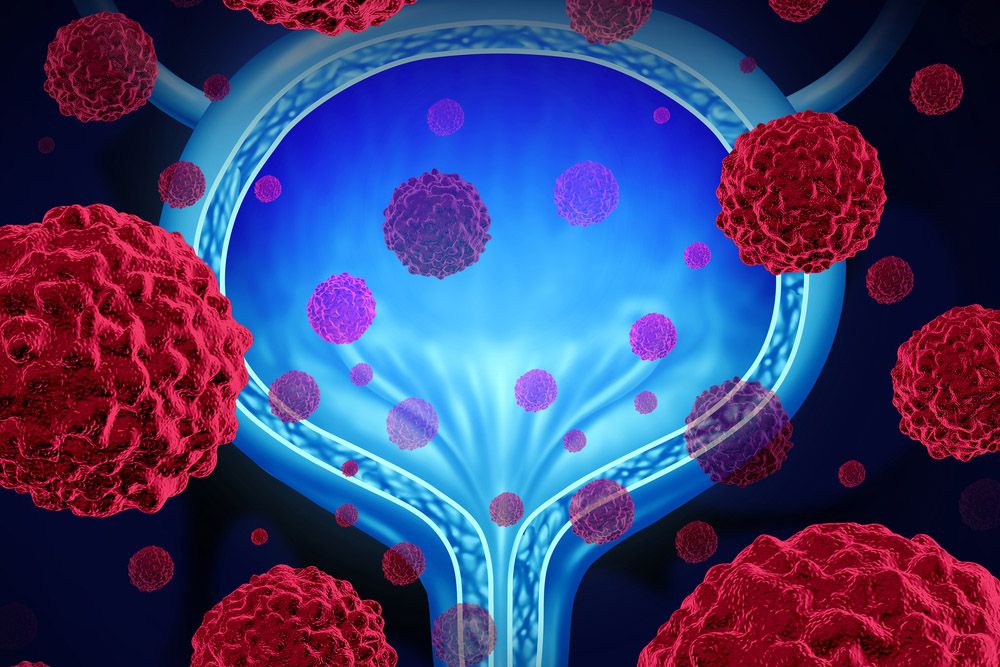EV-302 PRO Outcomes Find Consistent Efficacy Data in Urothelial Carcinoma
Patient-reported outcomes from the EV-302 trial found consistent efficacy and safety outcomes for patients with urothelial carcinoma.
Patient-reported outcomes from the EV-302 trial found consistent efficacy and safety outcomes for patients with urothelial carcinoma.

A significant improvement in progression-free survival (PFS) and overall survival (OS) was noted when enfortumab vedotin-ejfv (Padcev) plus pembrolizumab (Keytruda) (EV+P) were combined vs platinum-based chemotherapy without impacting patients with metastatic urothelial carcinoma quality of life, according to patient-reported outcome (PRO) data from the phase 3 EV-302 trial (NCT04223856).1
Previously reported data from the EV-302 trial showed that the combination of EV+P nearly doubled PFS and OS vs chemotherapy in patients with locally advanced or metastatic urothelial cancer.2 Specifically, the median PFS was 12.5 months with EV+P, vs 6.3 months in the chemotherapy arm (HR, 0.45; 95% CI, 0.38-0.54; P < .001), and the median OS was 31.5 months in the EV+P arm compared with 16.1 months in the chemotherapy arm (HR, 0.47; 95% CI, 0.38-0.58; P < .00001).
Updated data from the EV-302 trial were presented at the 2024 American Society for Clinical Oncology (ASCO) Annual Meeting by Shilpa Gupta, MD, director of Genitourinary Medical Oncology at Taussig Cancer Institute and Co-Leader of the Genitourinary Oncology Program at Cleveland Clinic in Cleveland, Ohio.
“We know that patients with locally advanced and metastatic urothelial cancer have a poor prognosis, with an estimated 5-year survival of less than 8% globally, and they have a high symptom and pain burden which impacts their quality of life and functioning,” Gupta noted during the presentation. “Here, we report the PRO data from the EV-302 trial, including impacts on patient's quality of life, functioning, and disease symptoms.”
Overall, at baseline, QOL and pain scores were balanced between the 2 arms.
Time to pain progression (TTPP) was previously reported, showing a median TTPP of 14.2 (6.6-not reached) months in the EV+P arm and 10.0 (5.9-not reached) months in the chemotherapy arm. No statistically significant difference between the 2 arms was observed (HR, 0.92; 95% CI, 0.72-1.2; P = .48).
Further, patients in the EV+P arm demonstrated larger improvements in worst pain per the Brief Pain Inventory Short Form (BPI-SF) assessment compared with those in the chemotherapy arm. However, neither arm reached the pre-defined thresholds for a clinically meaningful improvement.
Among those with moderate/severe pain at baseline (nearly one-third of patients), a clinically meaningful improvement in worst pain per BPI-SF was observed in both treatment arms. Those in the EV+P arm experienced greater improvements in pain compared with those in the chemotherapy arm.
The investigators also assessed changes in the EORTC Quality of Life Questionnaire (EORTC QLQ-C30), which measures global health status (GHS) and QOL. Patients in the EV+P arm demonstrated a transient worsening in GHS/QoL score at week 3, with a return to baseline at week 4. Patients in the chemotherapy arm demonstrated a worsening in GHS/QOL from week 1 through week 17, with a return to baseline from week 20. Overall, the median time to confirmed deterioration was 5.9 months in the EV+P arm vs 3.2 months in the chemotherapy arm (HR, 0.98; 95% CI, 0.79-1.2).
Among those with moderate/severe pain at baseline, patients in the EV+P arm showed a clinically meaningful improvement in GHS/QoL compared with the chemotherapy arm. Both cisplatin-eligible and cisplatin-ineligible patients in the EV+P arm showed a transient worsening in GHS/QOL through week 3, with a return to baseline at week 4. EV+P appeared to perform better in cisplatin-eligible patients compared with chemotherapy.
Additionally, patients in the EV+P arm demonstrated improved functioning across all functioning domains in the EORTC QLQ-C30 assessment compared with those in the chemotherapy arm, assessed by a change from baseline to week 26.
Overall, the patient compliance rate with the PRO assessments remained above 70% through week 17 in the chemotherapy arm and through week 29 in the EV+P arm. The investigators speculate that the difference may be due to differences in visit schedules after the end of protocol-defined treatment.
Safety data from the EV-302 study was consistent with previous studies and showed that EV+P was generally manageable.
In total, the EV-302 trial enrolled 886 patients with locally advanced or metastatic urothelial cancer who were randomly assigned 1:1 to receive either EV+P (n = 442) or to receive platinum-based chemotherapy (n = 444). All patients included in the trial were treated until disease progression, unacceptable toxicity, or the completion of maximum cycles. In the EV+P arm, there were no maximum cycles of EV, and there was a maximum of 35 cycles for pembrolizumab. In the chemotherapy arm, the maximum number of gemcitabine and platinum chemotherapy cycles was 6.
Patients filled out PRO questionnaires weekly for up to 12 weeks, equating to around 4 cycles, and then every 3 weeks after the end of treatment through disease progression and survival follow-up.
The primary end points for the trial were PFS per blinded independent central review (BICR) and OS. Key secondary end points included TTPP and change from baseline in BPI-SF worst pain at week 26.
Gupta concluded in the presentation, “The PRO data presented here complements the published clinical efficacy and safety data, add the patient's voice, and support the use of EV/pembro for patients with locally advanced/metastatic urothelial cancer.”
References
- Gupta S, Loriot T, Van der Heijden M, et al. Patient-reported outcomes (PROs) from a randomized, phase 3 trial of enfortumab vedotin plus pembrolizumab (EV+P) versus platinum-based chemotherapy (PBC) in previously untreated locally advanced or metastatic urothelial cancer (la/mUC). Presented at: 2024 American Society for Clinical Oncology Annual Meeting. May 31-June 4, Chicago, Illinois. Abstract 4502. https://ascopubs.org/doi/abs/10.1200/JCO.2024.42.16_suppl.4502
- Powles T, Valderrama BP, Gupta S, et al. Enfortumab vedotin and pembrolizumab in untreated advanced urothelial cancer. N Engl J Med. 2024;390(10):875-888. doi:10.1056/NEJMoa2312117